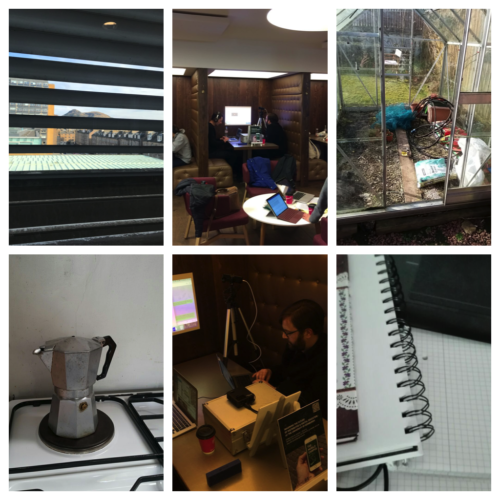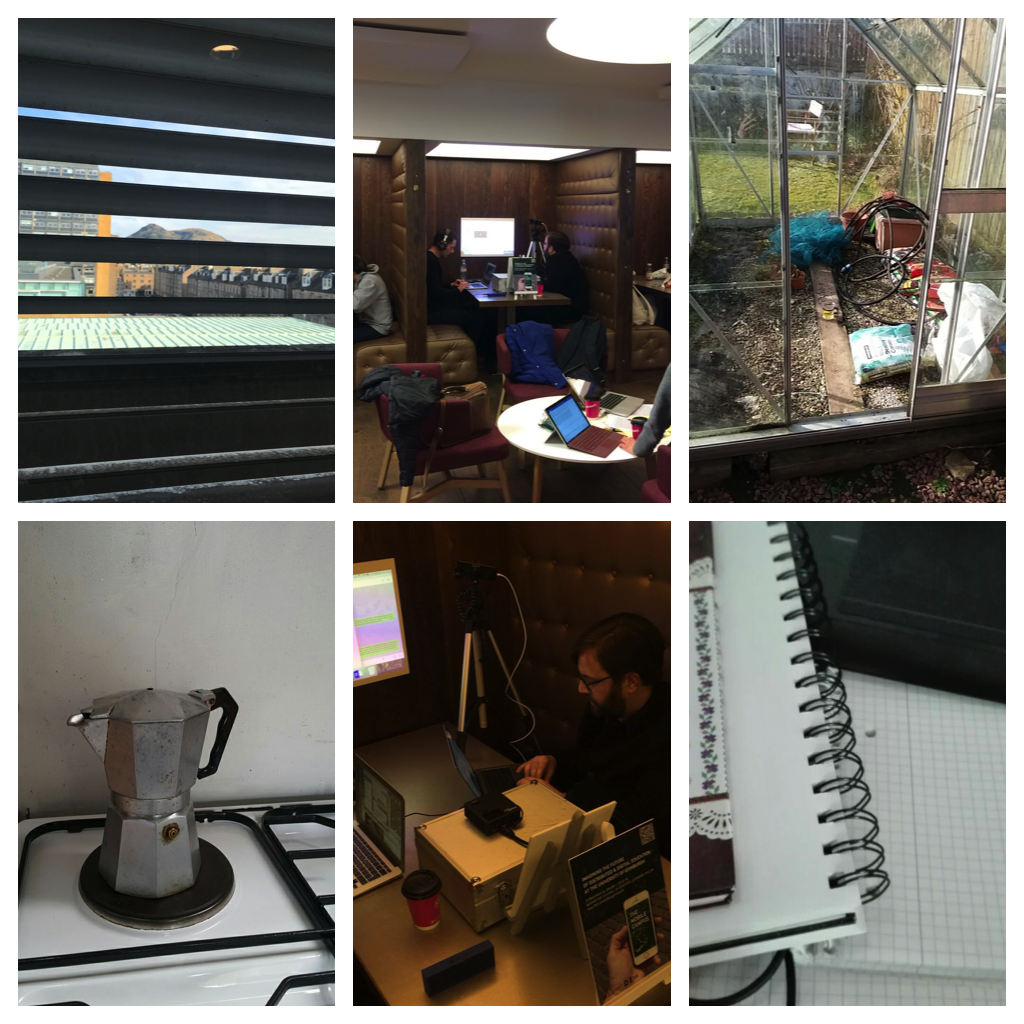
James Lamb and I recently ran a Festival of Creative Learning workshop at the University of Edinburgh, largely a showcase event for what is possible with mobile learning. We developed it loosely as running parallel to the Near Future Teaching project, so the project was largely future oriented, an attempt to push past ideas around what the future campus could possibly be. The salient details:
- 23 February at 13:00-14:00 GMT
- 31 registered and roughly 24 participating in a Telegram group
As such, the event had a core aim: to identify the future of the University of Edinburgh as seen through a mobile and highly distributed perspective. And to do so with members of the University of Edinburgh community wherever they might be: at home, at the office, at George Square, Kings Buildings, Moray House, on any of the campuses in Edinburgh or the thousands of smaller campuses that our distance students inhabit. We discussed, collected data, responded to our environment and each other, and had a mobile discussion around the future of the university. Kind of.
As with a previous mLearning event in Bremen, we used Telegram as our messaging service of choice. Just as in Bremen, this choice was largely predicated on an attempt, at least implicitly, to establish some security and some sense of privacy, both of which were and are challenged by the general ethos in universities towards openness.
With each of these mobile learning events, James and I try to push a bit further than the previous one, to introduce a new wrinkle, a new context or activity. In Bremen, this was about a structured field exploration but with distributed groups; in London, this was about an unstructured walk and a sense of place; some are solitary exercises, some are group oriented. The structure is an attempt to align the place, the audience, and the ethos of the event with the methods. Since this was about a bridging a distributed university, we wanted to have communication feeds going
- from participants to each other (Telegram)
- from participants to James and I and the traditional campus (again, Telegram)
- from James and I (and the traditional campus) to them (Telegram and livestream)
So we used Telegram as the activity space, and livestreamed James and I from 50 George Square using a mobile phone directly to YouTube Live, then embedded that livestream link into Telegram. So essentially the group could see and hear us discussing their responses and media. If that weren’t complicated enough, we projected onto the wall at 50 George Square the activity from Telegram. Not many could see it, but James and I used that as the basis of our discussion as well. So feeds going in a series of directions.
Over the course of an hour, the group discussed some questions, submitted audio and visual data, and. The audio data that participants submitted was remixed by James and projected out from 50 George Square using a bluetooth speaker. The sounds, images, and text that participants submitted became a part of the texture of the traditional campus, informing those at 50 George Square that there is a much broader campus at work. This broader campus coexisted with the traditional one.

Our Takeaways
These takeaways are more about structural issues and some first impressions and not about the salient themes emerging from the data itself. That will come later.
- Scale and activity needs to be managed: we kept the group open in terms of the number of participants and it peaked at around 30. For a discussion-oriented activity, this was likely too much although that really depends on the objectives. If this were a distributed field activity, for example, this would matter less as the group becomes more an inventory of data collected and then discussion around the data is minimal in the field itself. If this were a study group, perhaps it still works as the overall discussion can be referenced asynchronously. As a synchronous discussion oriented event (perhaps something to complement a formal curriculum), this would likely need to be managed. For our purposes, however, as a showcase to demonstrate how these distributed campuses might be linked, it was modestly successful.
- Scale and activity can be managed: we had toyed with some structural divisions but opted for the larger, chaotic group. It is indeed possible to run multiple, largely identical, simultaneous events across several groups (the groups speak to each other and not the larger group; they are largely unaware that there are other groups at all) using some SMS gateway like TextIt. So you could divide that 30 into four or five groups and as instructor feed into these groups individually. Technologically this is indeed possible and likely something I will pursue in the next iteration of this.
- Presence and streams: I am not sure livestreaming our location was an original part of the design, but it quickly become central to the overall activity. To save the suspense, livestreaming oneself doing seemingly pedestrian tasks (essentially typing and talking) is not a natural state. It take some getting used to, but we felt it was validated but what we set out to do, namely about bridging the campuses and not privileging our own at 50 George Square. Streams coming from the Telegram group to us at 50 George Square were being broadcast out into the cafe (via James’ remix) and our stream was broadcast to them in the Telegram group. This bears some further exploration but this two way, largely ambient channel presents some possibility largely for establishing connections and presence, however ephemeral. It negates a bit of the accessibility that mobile provides (as it is more bandwidth intensive) but I want to explore this more in future events.
- Context collapse: this is a pronounced issue with mobile and social media, but it needn’t always be a negative one. Informal, formal, social, intimate, and public worlds are intertwined in these spaces and in mobile, where the only distinction between these worlds are its signage (the app logo, the name of the thread on the messaging service, the red notification with the number on your phone homepage. Within this Telegram group, worlds collided and contexts collapsed. Conventions of mobile phone use: informality and rapid banter and their juxtaposition against the academic intent of the activity driving it. The intimacy of the media (audio and imagery largely depicting work or study spaces, often in domestic environments) juxtaposed against the largely public space in which we were transmitting this exercise. When we do a proper analysis of the data, I want to pick up on Davis & Jurgensen’s (2014) ideas around context collusions, an intentional collapsing of contexts, and context collisions: an unintentional collapsing of contexts. Some of this was collusions and some were collisions.
- Instructional presence can be extended with assistance: so we had also toyed with making the instructional prompts (discuss this, collect audio data, etc.) automated via a bot, in case we needed to manage large groups. Telegram allows for native bots to be created, and TextIt allows these communication flows to be automated (which is essentially a bot) with each successive prompt triggered by student activity before. MichaelBot was tested, added to the group, yet remained dormant. What this provides from an instructional perspective is extended capacity: the bot triggers the activity and the instructor engages the resulting discussions. A friend tipped me to another one that looks quite good and with which I am building a bot now: RunDexter.

Why Mobile
I drone on a lot about mobile learning. I am both fascinated by the subject pedagogically and believe it has the larger purpose of widening participation. Most universities are designing large segments of the world’s population out of education largely through our use of ICT: Africa, which has mobile penetration of 82% and internet penetration of of only 34%; Asia-Pacific with mobile penetration at near 100% and internet penetration at 48%, and on (We Are Social, 2018). Computer home ownership is rare throughout most of the world; broadband connectivity even less so. Mobile is and will remain the ICT of first, and in some cases only, use. We default to broadband and desktop/laptop friendly LMS; we default to talking head videos that are resource consuming, and we default to these largely out of legacy. This is how we perceive the norm to be. And perhaps that is indeed true for most of the UK (not all, though). However, with more and more universities expanding their digital education provisions and with more and more boundaries between campuses, between domestic and international distinctions being blurred, perhaps it is time to take a hard look at the ICT of greatest penetration worldwide. Perhaps some of our choices (livestreaming in particular) negated that accessibility but we needed to do both: push on the edges of what was possible and make it accessible. Whether or not we did both remains an open question. That is all.

[…] of Distributed Education at the University of Edinburgh, run by two colleagues, James Lamb and Michael Gallagher [see end of post for their respective blogs or click on their names for details on the event]. This […]